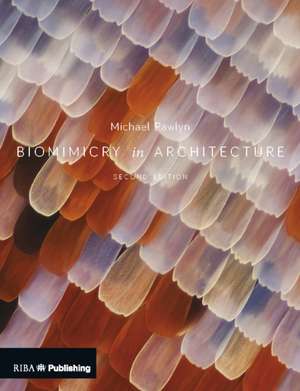Biomimicry in Architecture
Autor Michael Pawlynen Limba Engleză Paperback – 6 oct 2016
For architects, urban designers and product designers, this new edition of Biomimicry in Architecture looks to the natural world to achieve radical increases in resource efficiency. Packed with case studies predicting future trends, this edition also contains updated and expanded chapters on structures, materials, waste, water, thermal control and energy, as well as an all-new chapter on light.
An amazing sourcebook of extraordinary design solutions, Biomimicry in Architecture is a must-read for anyone preparing for the challenges of building a sustainable and restorative future.
Preț: 290.00 lei
Nou
Puncte Express: 435
Preț estimativ în valută:
55.49€ • 57.94$ • 45.93£
55.49€ • 57.94$ • 45.93£
Carte disponibilă
Livrare economică 14-28 martie
Livrare express 27 februarie-05 martie pentru 36.76 lei
Preluare comenzi: 021 569.72.76
Specificații
ISBN-13: 9781859466285
ISBN-10: 1859466281
Pagini: 176
Dimensiuni: 190 x 250 x 20 mm
Greutate: 0.56 kg
Ediția:Revised
Editura: Riba Publishing
Colecția RIBA Publishing
ISBN-10: 1859466281
Pagini: 176
Dimensiuni: 190 x 250 x 20 mm
Greutate: 0.56 kg
Ediția:Revised
Editura: Riba Publishing
Colecția RIBA Publishing
Public țintă
Professional and Professional Practice & DevelopmentCuprins
1. How Could We Build More Efficient Structures? 2. How Will We Manufacture Materials? 3. How Will We Produce our Energy? 4. How Will We Get Fresh Water? 5. How Will We Create Zero-waste Systems? 6. How Will We Control our Thermal Environment? 7. How Will We Gather and Distribute Light? Synthesis
Notă biografică
Michael Pawlyn is an architect and has a well-earned reputation as a pioneer of biomimicry. Before setting up his own practice, Exploration Architecture Ltd., he worked with Grimshaw Architects for ten years and was central to the team that radically re-invented horticultural architecture for the Eden Project. He lectures widely on the subject of sustainable design.
Descriere
Packed with case studies predicting future trends, this edition contains updated and expanded chapters on structures, materials, waste, water, thermal control and energy, as well as an all-new chapter on light.





